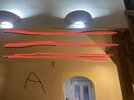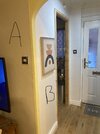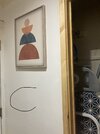Hello. I’m wanting to take out 3 walls to make the living room open plan with the kitchen. I’m sure the walls are just partition stud walls as I’ve drilled through them to attach various things. However, I’m sure I’ve read somewhere that stud partition walls can also be load bearing?
The wall ‘A’ I’m wanting to extend the arch and take out the remaining wall indicated by the green line. The red lines on the ceiling represent the beams I’ve located. Wall ‘B’ that runs at 90* to wall ‘A’ appears to be a stud wall around 70mm think the same as wall ‘C’ which I’m also wanting to take out.
Is there any way I can check further?
The wall ‘A’ I’m wanting to extend the arch and take out the remaining wall indicated by the green line. The red lines on the ceiling represent the beams I’ve located. Wall ‘B’ that runs at 90* to wall ‘A’ appears to be a stud wall around 70mm think the same as wall ‘C’ which I’m also wanting to take out.
Is there any way I can check further?






